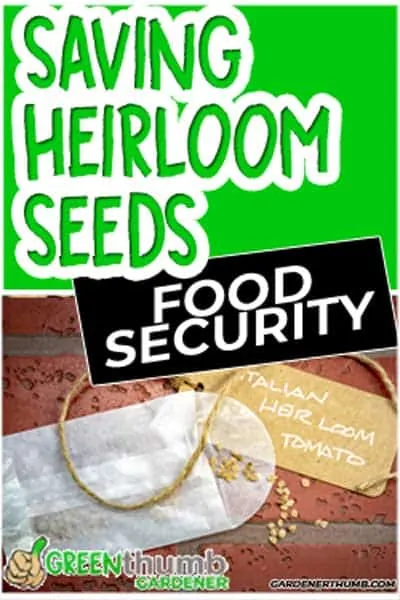Why Are Heirlooms Important To Food Security?
Last updated 07/21/20
I think you’ll agree that asking the question, are heirlooms important to food security is sound reasoning. The logic is self-evident if you realize that the seeds we know and plant today were handed down through generations.
Imagine if people then didn’t keep them and were lost forever? It would be utter chaos, hunger, civil disorder and strife wouldn’t it!
Luckily plants were nurtured, saved and developed for our sake and those to follow.
Green thumb Gardener occasionally links to product and/or services offered by vendors to assist you with all your gardening needs. Some of these may be affiliate links, meaning we earn a small commission if items are purchased.
Want to Download a Garden Hack Guide for FREE

Enter your email below and we will send you a guide to help you SAVE money in your garden.
Improvement of Food Security
You’d think that the Romans had it all figured out by their own genius crossbreeding. The farmers had success in growing and harvesting purple and white carrots. Most likely they took the carrots from the conquered tribes who grew the crops.
They took or were given heirlooms and because of them, the Romans had sizable food supply and a healthy population, not to mention the gifts of bread to the masses kneaded from grain obtained from the same source.
We may not want to emulate their methods of commandeering seeds from the farmers who nurtured and saved them. We may want to do what the conquered people did by saving them.
Role of Seed Saving
This is how saving seeds can play a vital role in sustaining security of a food system now and in the future. Saving them would promote seed genetic diversity and would allow some crop strains to withstand a climate change.
Other seeds may speed up or slow down their growth cycles to suit prevailing climatic conditions.
For instance some plants may be grown to provide the best nutrition for people, while fast maturing plants may adapt to shorter growing seasons.
This practice will provide a two-pronged method of growing plants during normal seasons and another for growing plants over shorter periods due to faster growing plants that fruit faster over shorter periods.
The practice would ensure a continuous flow of a food system at different times everywhere and both methods would be sustainable. We have a sustainable food supply situation!

Enhances Power to Save Seeds
About 60% of all protein and calories produced worldwide come from maize, wheat and rice. It has caused serious concern about sustainable.
This is due to the disruption of a food system from climatic changes in temperature, rainfall and other weather phenomena. Diversified farmers has dwindled to a fraction of what it used to be due to plant species succumbing to disease from pests and harsh weather conditions.
Nevertheless, these adverse conditions may be blessings in disguise because it has made us more aware that plant diversity is the very answer to the deteriorating situation for our food supply.
In order to achieve that genetic diversity we need to have heirloom seeds that will sprout into different species of plants that produce a healthy food system. So yes, saving heirloom varieties of seeds may be the very solution to our woes and our other concerns.
Survive the Storms Ahead
It is dangerous for farmers to fully rely on only a few varieties of food to sustain a world population of over 7 billion.
It’s dangerous and unsustainable and therefore the need to work towards improving the varieties of food crops that yield a bounty of crops has to become a top priority.
In the effort to achieve plant diversity we would also be providing an excellent environment for introducing more plant species that may stand a better chance of adapting to extreme weather conditions whether cold, hot, rainy or dry.
It is clear that if this is the approach to take, the task of saving heirloom seeds will develop a reserve of seeds.
This would not only succeed in making heirloom seeds available and accessible, but would also make saving heirloom varieties one of the most important jobs of our times.
Security of resources would be sustainable over the long term and this is exactly what the world needs right now given the types of weather hazards we’ve experienced in the past.
Improvement of Biodiversity
So what then is saving seeds of heirloom varieties? Simply put, it’s the harvesting and storing of seeds from grain herbs, vegetables and even flowers. These seeds would be used in cross-breeding with other seeds for creating plant diversity that can adapt more readily to adverse conditions.
This in actual fact is biodiversity in the making with attention focused solely on a miniature task – that of cross breeding – which produces gigantic results.
Biodiversity has always featured greatly in our bid to ensure a sustainable goal from the interplay of millions of ecosystems from the smallest to the largest living plant and animal species on a global scale.
However, more than ever, we’ve been pushed into a corner by a huge crisis of climate change that’s threatening our very existence.
It has impacted our ability to procure a large enough food system.
So we should in fact be thinking small in order to achieve gigantic results.
That can only materialize if we give nature a helping hand by creating a huge variety of new plants that can produce a bountiful food system.
The FAO has found that of the 6000 plant species now being cultivated, only nine of them produce 66% of the entire crop production.

What Does This Tell Us?
That mono-culture farming has come under great pressure and may no longer be sustainable given huge increases in population worldwide, attacks by pests and the ever changing climatic patterns.
The answer seems to lie in man’s ability to diversify plant species that are able to produce and use them in community sized farming activities everywhere to sustain their population.
The world can no longer depend entirely on only a few crops in a sustainable manner.
Rather, most should spend time and effort in improving the diversity of crops to supply different varieties of crops that can better withstand the impacts of climatic change.
In doing so we would be improving on the existing biodiversity by introducing more varieties of plants to increase our food system.
Protects Healing Knowledge
There is a real danger with the deteriorating nature of biodiversity in which small and large ecosystems are slowly dying out. This lets us know that nature can no longer sustain itself due to this irreparable loss.
A chain reaction sets in and we find a similar development happening to the knowledge of healing.
The main danger is that we are getting more and more isolated from nature’s influence. In the past, folks depended on healing processes that called on the help of nature.
For example, herbs were widely used in ancient rural communities and villages for healing. Now modern medicine has taken its toll. This is not to belittle this development but only to moan the loss of what had already been there which was successful.
With seed saving, traditional healing sources, abilities and skills may once again flourish amidst a biodiversity resurgence.
We would be able once again to find the plants, medicinal herbs and other natural cures of diseases that can return us to perfect health.
Here we again see the blessing that saving heirloom varieties can bring back to the knowledge of healing the traditional way.
So it’s not only our food supply that would flourish and become sustainable from saving heirlooms but also healing knowledge will be revitalized and maintained.

Promotes Seed Availability and Accessibility
Perhaps another aspect that will play an important role in a revitalized biodiversity will be the availability and accessibility of heirlooms.
There are many awakenings taking place in response to the deterioration of biodiversity. Folks are becoming aware of the dire nature of biodiversity that they are forming groups and communities that would store, use, protect and distribute saved heirlooms.
One reason among many that’s causing this to happen is that people are now becoming aware of the resilience of heirloom seeds as opposed to genetic seeds.
Seeds Stand the Test of Time
Heirlooms have traveled through long years of erosion, famine, hot, cold and other climatic tantrums. By surviving through these conditions, they have developed resistance and enduring traits against exceedingly adverse conditions.
In doing so, they become the ideal kind of heirlooms that would survive in any turmoil whether natural or man made.
Heirlooms have lived through times of deadly wars, explosions, gases, fire and even through nuclear tests like the coconuts and other ubiquitous plants of the Pacific.
Yes heirlooms survived them all and it’s only just and wise to give them that recognition, another chance to play the hero and help rejuvenate an ailing biodiversity.
Final Thoughts
Perhaps it’s the perfect time to be thinking back to the old days.
A time when agricultural practice was done amidst a robust biodiversity and where farmers planted, harvested and saved their seeds for the next planting season.
Related Questions
- Why are heirloom seeds important? – Heirloom plants produce better taste and flavor and heirloom fruits are well-known for their nutritious quality which promotes health. They also preserve the genetic diversity of plants & a stronger food system.
- Why are heirloom foods gaining popularity? – A nostalgic recall of the past is a big factor. People want to get away from modernized farming and experience a real heritage food system once again. The flavor and healthier food produced from heirloom seeds also play a part.
- What does an heirloom label mean? – A heirloom label means to be labeled as heirloom fruit, vegetable, or herb or being grown from saved heirloom plants. Heirloom seeds are also labeled for their ability in resisting pests, disease, and intense environmental changes and from that experience, they have a better chance of surviving in the future.
- What makes a vegetable heirloom? – A vegetable is regarded as a heirloom when it has been grown from a seed that was saved and grown over the years and is passed down to successive generations by the first farmer.








